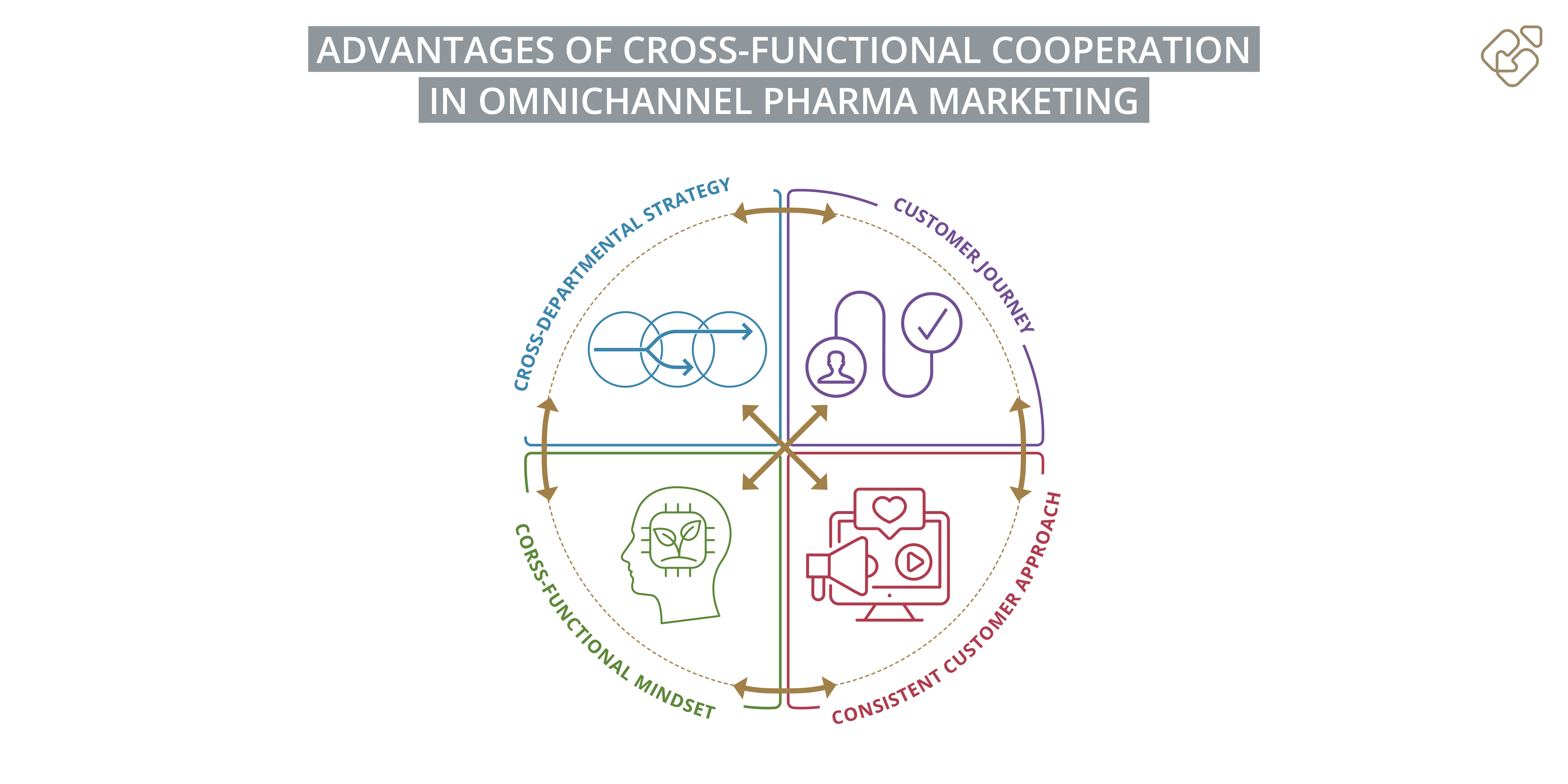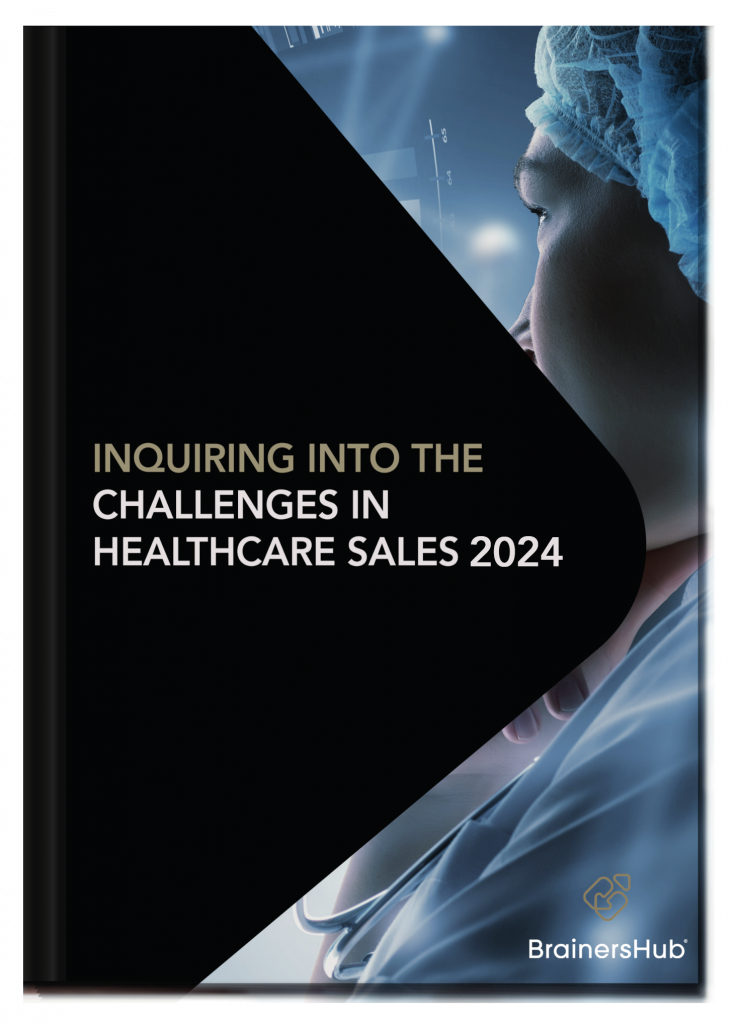Part 4 of the article series: Omnichannel Pharma Marketing
In recent years, omnichannel pharma marketing (OCM) has emerged as a pivotal development in the pharmaceutical market. In this article series, we aim to provide comprehensive insights into OCM, covering the following key aspects:
1. What is Omnichannel Pharma Marketing?
2. Why is Omnichannel Pharma Marketing so relevant for pharmaceutical companies right now?
3. How does Omnichannel Pharma Marketing work?
Part 1: Customer Journey in Omnichannel Pharma Marketing
Part 2: Channels in Omnichannel Pharma Marketing
Part 3: Data Management in Omnichannel Pharma Marketing
4. The Advantages of Omnichannel Pharma Marketing
5. What Impact does Omnichannel Pharma Marketing have on the Success of Pharmaceutical Companies?
+ Whitepaper: Implementation of Omnichannel Pharma Marketing
One of the most crucial functions of Omnichannel Pharma Marketing (OCM) is to bridge the current challenges faced by pharmaceutical companies with future trends and requirements. The omnichannel approach, therefore, focuses on five key advantages that lay the strategic foundation for future success. The goal is to adapt step by step to the challenges in the pharmaceutical market and proactively shape change rather than merely react to it:

1. Customer Centricity
At the core of OCM lies a strong customer focus, enabling pharmaceutical companies to tailor their activities and communications more effectively to their target audience's specific needs. This advantage plays a central role in building sustainable relationships with physicians and gaining their trust as customers (see: Effects on the Customer Relationship). OCM provides three key advantages for pharmaceutical companies:
-
- Mindset: The strong customer focus in OCM promotes the development of a new self-image in pharmaceutical sales. Whereas traditionally the focus has been on the company's own products and how these can be "sold" to the target group, OCM shifts this focus towards customers and their needs. The core question for pharmaceutical companies becomes, how they can best support them, leading to a deeper understanding of physicians' perspectives.
- Innovation: Embracing the new customer-centric self-image fosters innovation within the pharmaceutical market. By viewing themselves as problem solvers for their target audience rather than mere drug manufacturers, pharmaceutical companies explore new avenues, such as developing innovative solutions and offerings (e.g., information platforms for physicians or patient apps that support therapy). This may even give rise to new business models in the form of so-called "Beyond the Pill" solutions that are increasingly gaining importance alongside conventional medicines.
- Feedback Loops: OCM emphasizes transforming communication from a “one-way street” into a dialogue. Besides their original messages, pharmaceutical companies focus increasingly on the reactions of their target audience. By creating a robust Data Infrastructure and capturing target group reactions reliably, valuable data, reactions, and insights can be gathered at every point of contact. This enriches physicians' customer profiles and helps companies gain a deeper understanding of their target audience.
- Mindset: The strong customer focus in OCM promotes the development of a new self-image in pharmaceutical sales. Whereas traditionally the focus has been on the company's own products and how these can be "sold" to the target group, OCM shifts this focus towards customers and their needs. The core question for pharmaceutical companies becomes, how they can best support them, leading to a deeper understanding of physicians' perspectives.

FREE WHITEPAPER
How to Implement Omnichannel Pharma Marketing in Practice?
- 5 Steps to Success - OCM Implementation Roadmap
- 5 Best Practices in Successful OCM Implementation
- 3 Success Factors that make the Difference in Practice
2. Soften Information Silos
A key benefit of OCM lies in softening information and knowledge silos by enabling seamless access to scattered knowledge from individual sales and marketing areas throughout the company. This offers two important benefits:
- Transparency: OCM ensures that all knowledge about the target audience is visible across the entire company through enhancing information flow and centralized access to customer information. This comprehensive overview of all interactions with a respective physician provides employees with a more detailed picture, allowing them to adopt their activities accordingly.
- Linking knowledge: OCM fosters transparency and facilitates the linking of knowledge from various areas of the company, allowing each team and channel to contribute unique facets to the overall understanding of the target group. This collaborative approach resembles assembling a jigsaw puzzle, where each customer interaction adds valuable pieces to the comprehensive picture. The power of OCM lies in the collective nature of information integration, eliminating isolated perspectives and creating a unified whole. Consequently, a wealth of knowledge becomes available to all company areas, while uncovering novel connections (e.g., when performance marketing data is linked with information from field sales contacts) and insights previously unseen within individual domains. This reservoir of comprehensive customer information synergizes to form a knowledge store greater than the sum of its parts, empowering pharmaceutical companies to make informed decisions, drive innovation, and tailor strategies effectively to meet customer needs.
- Transparency: OCM ensures that all knowledge about the target audience is visible across the entire company through enhancing information flow and centralized access to customer information. This comprehensive overview of all interactions with a respective physician provides employees with a more detailed picture, allowing them to adopt their activities accordingly.
3. Cross-Functional Cooperation
In OCM, the practice of linking different areas of responsibility goes beyond merely sharing information. It places a strong emphasis on fostering collaboration among diverse teams and channels within sales and marketing. The goal is to harness the unique strengths of each area and cultivate more robust synergies between them.

- Cross-divisional strategy: OCM places great emphasis on realigning processes and workflows within the company. Processes no longer end at divisional boundaries but deliberately link the activities of various divisions. This creates important interfaces for exchange and collaboration. A significant driver for this change is linking the strategy development of the individual divisions with each other. To this end, decision-makers from various areas are integrated into the development process allowing them to represent the needs and opportunities from the perspective of their teams. This creates a dialog on how their goals and strengths can best be linked to jointly contribute to the success of the company.
- Customer Journey: A key building block in OCM that particularly benefits from a cross-divisional strategy is the Customer Journey. It aims to coordinate the various touchpoints with the target group (e.g., content marketing, e-mail, sales force visits) around the needs of physicians. This ensures that individual marketing and sales activities are connected into a coherent communication flow guiding physicians through their decision-making process. As a result, the effect of each individual measure is enhanced as it transforms from an isolated point of contact to a link in a coherent chain of touchpoints.
- Unified customer approach:
Strong coordination and collaboration between different sales and marketing areas allow pharmaceutical companies to unify their customer approach. This enables tailoring communications at each touchpoint, emphasizing core messages, and adapting messages according to the customer's position in the decision-making process.
Both strong coordination of the different sales and marketing areas and collaboration at a strategic level help pharmaceutical companies unify their customer approach. This allows pharmaceutical companies to consciously tailor communications at each touch point to emphasize their core messages. At the same time, individual messages along the customer journey can be tailored to where the physician is in the decision-making process. This allows pharmaceutical companies to successfully unfold their brand message across multiple touchpoints and emphasize the facets that are most relevant to the target group at the current time.
- Cross-functional mindset: The effect of OCM on the workforce is of great importance, too, as employees need to understand how they can benefit from OCM and what contribution they make to its success. That's why the implementation process of OCM starts precisely with that (see Whitepaper: Implementing Omnichannel Pharma Marketing). The goal is to enable employees to view marketing and sales processes less from a divisional perspective (e.g., what does area of responsibility X do vs. what does area Y do?) and more from the customer's perspective (e.g., how and where can we help doctor X in the most effective way? How and where can we best pick up doctor X with his need Y?). This creates a mindset that values each activity in the context of how it contributes to the customer journey at large. Hence, it inspires teams to jointly develop solutions that fit the respective customers and their needs.
- Cross-divisional strategy: OCM places great emphasis on realigning processes and workflows within the company. Processes no longer end at divisional boundaries but deliberately link the activities of various divisions. This creates important interfaces for exchange and collaboration. A significant driver for this change is linking the strategy development of the individual divisions with each other. To this end, decision-makers from various areas are integrated into the development process allowing them to represent the needs and opportunities from the perspective of their teams. This creates a dialog on how their goals and strengths can best be linked to jointly contribute to the success of the company.

Free whitepaper
Challenges in Healthcare Sales 2024
- The biggest Challenges in Healthcare Sales 2024
- The hottest Trends in Healthcare Marketing
- What Sales Experts Wish For
4. Personalized Dialog
A key benefit of OCM is to promote the company's ability to respond more individually to the needs of physicians - to create a personalized dialog. This involves actively listening to and capturing each physician's specific interests, needs, and preferences on the one hand and tailoring communications and actions accordingly on the other:
- Relevance: Personalization is essential in OCM due to the increasing competition for physicians' attention. Pharmaceutical companies must stand out amidst the growing volume of advertising messages and content when targetting medical professionals. By tailoring content to physicians' individual needs, OCM increases its relevance and consequently the likelihood of interaction and engagement.
- Automation: Since personalization is usually accompanied by a significant increase in workload, pharmaceutical companies need to find ways to manage their personalized approach efficiently. In OCM, setting up an adequate Data Infrastructure plays a vital role in facilitating customization processes and task automation. Sophisticated software systems (e.g., CRM, CLM) can help to effectively manage certain sales sequences (e.g., follow-ups, newsletters) or data analytics (e.g., segmentation, prioritization), enabling efficient customization even on a larger scale.
- Relevance: Personalization is essential in OCM due to the increasing competition for physicians' attention. Pharmaceutical companies must stand out amidst the growing volume of advertising messages and content when targetting medical professionals. By tailoring content to physicians' individual needs, OCM increases its relevance and consequently the likelihood of interaction and engagement.
5. Targeted Digitization
The omnichannel approach plays a crucial role in the digitization of pharmaceutical sales and marketing, providing a strategic framework for the transformation process. OCM's Main Principles (Customer Insights, Customer Centricity, and Customer Journey) offer numerous opportunities to benefit from digital measures:

- Engage digital channels: The emergence of various new digital channels for sales and marketing (e.g., SEO, social media, webinars, physician platforms, etc.) offers numerous new opportunities to pharmaceutical companies. Nevertheless, in practice, pharmaceutical companies often struggle to implement these channels effectively. Particularly challenging is the meaningful integration of digital measures into current sales and marketing processes. This is where companies can greatly benefit from the Customer Journey in OCM, which allows them to link digital communication and conventional measures in a targeted manner. Digital channels hence don't end up as just another mouthpiece parallel to the existing ones, instead, they reach physicians where traditional channels may not have been as effective (e.g., online research, social media, etc.). Additionally, they may even amplify the effectiveness of conventional measures through activities like automatic email follow-ups or supplementary online content.
- Measurability: Another important aspect of OCM is to make the company's sales and marketing activities more measurable by formulating concrete performance indicators for all measures (e.g., registrations, response rate, clicks, etc.). This allows making the effectiveness of those measures more visible, enabling systematic testing of new ideas and activities while providing teams with valuable feedback that allows them to learn more quickly and continuously optimize their decision-making.
- Data-driven decisions: Measurability creates a valuable basis for the way decisions are made in pharmaceutical companies. After all, the more detailed and accurate data is available, the better it can be used for decision-making. OCM thus focuses on developing the necessary infrastructure to process data effectively and make it usable for employees.
- Central data infrastructure: While setting up technical solutions may not be the first step in implementing OCM (see Whitepaper: Implementing Omnichannel Pharma Marketing), increasing emphasis will be placed on connecting different information channels and areas of responsibility during its implementation. The goal is to have all customer data flow into a central customer profile, which is facilitated by a central data infrastructure that enables gaining detailed customer insights and coordinating marketing and sales activities successfully, including the automation of select marketing and sales sequences.
- Engage digital channels: The emergence of various new digital channels for sales and marketing (e.g., SEO, social media, webinars, physician platforms, etc.) offers numerous new opportunities to pharmaceutical companies. Nevertheless, in practice, pharmaceutical companies often struggle to implement these channels effectively. Particularly challenging is the meaningful integration of digital measures into current sales and marketing processes. This is where companies can greatly benefit from the Customer Journey in OCM, which allows them to link digital communication and conventional measures in a targeted manner. Digital channels hence don't end up as just another mouthpiece parallel to the existing ones, instead, they reach physicians where traditional channels may not have been as effective (e.g., online research, social media, etc.). Additionally, they may even amplify the effectiveness of conventional measures through activities like automatic email follow-ups or supplementary online content.
Together, these five factors form the basis of OCM's success. In the next part of our Editorial on "Omnichannel Pharma Marketing", we will explore how these advantages translate into concrete benefits for pharmaceutical companies by exploring the following three levels:
1. The Effects on Pharmaceutical Marketing and Sales
2. The Effects on Customer Relations
3. Effects on Company Success
EXPERT
Nicole Ehrhardt – Partner & Business Director

Erfolgreiches Projektmanagement mit und ohne Projektmanagement Beratung
Projektmanagement als Schlüssel zu langfristigen Erfolg: ✔️ Effiziente Ressourcenallokation ✔️Risiken minimieren ✔️Strategischen Ziele sichern

The Advantages of Omnichannel Pharma Marketing
Learn about the advantages of Omnichannel Pharma Marketing and how your company can benefit from them:
✔️ Customer centricity
✔️ Breaking down information silos
✔️ Cross-functional cooperation

Understanding Data Management in Omnichannel Pharma Marketing
Learn how data management works in Omnichannel Pharma Marketing and how pharma sales and marketing can benefit from it:
✔️ Data processing
✔️ Data infrastructure
✔️ Using data in practice
